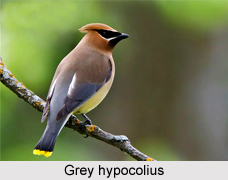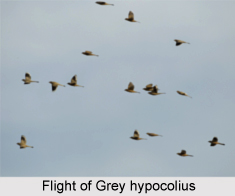 Grey Hypocolius or Simply Hypocolius is an Indian bird that bears a scientific name "Hypocolius ampelinus" and belongs to the family of Hypocoliidae.
Grey Hypocolius or Simply Hypocolius is an Indian bird that bears a scientific name "Hypocolius ampelinus" and belongs to the family of Hypocoliidae.
Concentration of Grey Hypocolius
Grey Hypocolius or simply Hypocolius is a slender and long tailed bird, found in the dry semi-desert region of northern Africa, Arabia, Afghanistan, Pakistan, and western India. They fly in flocks and forage mainly on fruits, migrating south in winter.
Structure of Grey Hypocolius
Grey Hypocolius is a slim bird with a long tail, slight crest and thick, short hook-tipped bill. Its shape and soft, satiny plumage resembles that of the waxwing. Birds are mainly of uniform grey or brownish-grey colour, with males having a black triangular mask around the eyes. They have white-tipped black primary wing feathers and a black terminal band on the tail. Adults are about 19-21 cm in length.
Behaviour of Grey Hypocolius
Grey Hypocolius has the head feathers raised when the bird is excited. They fly in a straight non-undulating style and when hopping in shrubbery, can appear like a babbler. The tarsus is short and sturdy with coarse scales. There are rictal bristles visible at the base of the bill and the nostrils are exposed, small and oval. The relationships of the Grey hypocolius are unclear.
Range of Grey Hypocolius
Grey Hypocolius ranges through the Middle East, breeding in the Iraq, Iran, Afghanistan, Pakistan, Turkmenistan area, and wintering mostly near the Red Sea and Persian Gulf coasts of Arabia, including Bahrain. It is a vagrant to Turkey, Israel, Egypt and Oman. They are regular winter visitors to the Kutch region of western India and vagrants have been noted as far south as Kihim near Mumbai. It is found in woodland and scrub in arid and semiarid regions, especially river valleys near deserts, as well as in irrigated and cultivated areas with trees, such as palm groves and gardens.
 Flight of Grey Hypocolius
Flight of Grey Hypocolius
Grey Hypocolius is a shy and unobtrusive, even cryptic, bird which will fly to thick cover when disturbed, where it will remain motionless until the perceived danger has passed. Its flight is strong and direct (without undulations). It will form flocks, especially in winter, and roost communally.
Breeding Season of Grey Hypocolius
The breeding season of Grey Hypocolius is from June or July in Arabia. The nest of Grey Hypocolius is cup shaped and deep lined with hair and fluff. The nest is often placed on the leaves of a date palm at a height of about 3 to 5 feet. Both the male and female take part in nest building. The clutch is four eggs. The eggs are leaden white with blotches. The incubation period is about 14-15 days.
Forage of Grey Hypocolius
Grey Hypocoliuses forage quietly and methodically in foliage, through clusters of trees, palm groves and orchards, rarely coming to the ground. Though they may eat some insects, their main diet consists of fruits and berries, including mulberries, figs and dates. In captivity they have been known to readily take bread.
Sound of Grey Hypocolius
The most common vocalization of Grey Hypocolius is a series of squealing descending notes or kleeeu whistles. Other calls include scolding chirps.



















